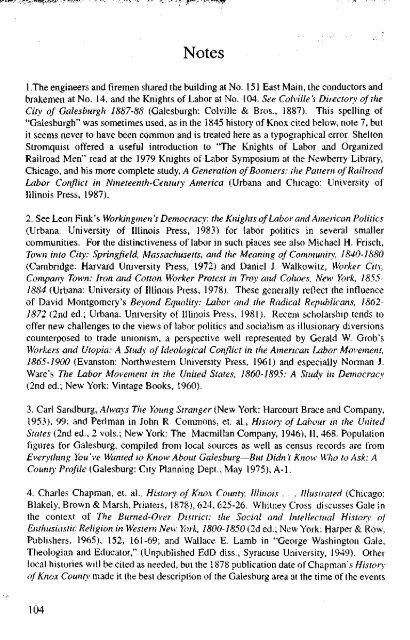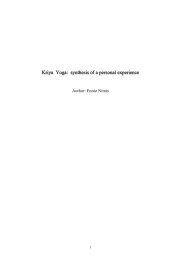"The Cruel Striker War" - NIU Digital Projects
"The Cruel Striker War" - NIU Digital Projects
"The Cruel Striker War" - NIU Digital Projects
Create successful ePaper yourself
Turn your PDF publications into a flip-book with our unique Google optimized e-Paper software.
Notes<br />
1. <strong>The</strong> engineers and firemen shared the building at No. 151 East Main, the conductors and<br />
brakemen at No. 14, and the Knights of Labor at No. 104. See Colville's Directory of the<br />
City of Galesburgh 1887-88 (Galesburgh: Colville & Bros., 1887). This spelling of<br />
"Galesburgh" was sometimes used, as in the 1845 history of Knox cited below, note 7, but<br />
it seems never to have been common and is treated here as a typographical error. Shelton<br />
Stromquist offered a useful introduction to "<strong>The</strong> Knights of Labor and Organized<br />
Railroad Men" read at the 1979 Knights of Labor Symposium at the Newberry Library,<br />
Chicago, and his more complete study, A Generation of Boomers: the Pattern of Railroad<br />
Labor Conflict in Nineteenth-Century America (Urbana and Chicago: University of<br />
Illinois Press, 1987).<br />
2. See Leon Fink's Workingmen's Democracy: the Knights of Labor and American Politics<br />
(Urbana: University of Illinois Press, 1983) for labor politics in several smaller<br />
communities. For the distinctiveness of labor in such places see also Michael H. Frisch,<br />
Town into City: Springfield, Massachusetts, and the Meaning of Community, 1840-1880<br />
(Cambridge: Harvard University Press, 1972) and Daniel J. Walkowitz, Worker City,<br />
Company Town: Iron and Cotton Worker Protest in Troy and Cohoes, New York, 1855-<br />
1884 (Urbana: University of Illinois Press, 1978). <strong>The</strong>se generally reflect the influence<br />
of David Montgomery's Beyond Equality: Labor and the Radical Republicans, 1862-<br />
1872 (2nd ed.; Urbana: University of Illinois Press, 1981). Recent scholarship tends to<br />
offer new challenges to the views of labor politics and socialism as illusionary diversions<br />
counterposed to trade unionism, a perspective well represented by Gerald W. Grob's<br />
Workers and Utopia: A Study of Ideological Conflict in the American Labor Movement,<br />
1865-1900 (Evanston: Northwestern University Press, 1961) and especially Norman J.<br />
Ware's <strong>The</strong> Labor Movement in the United States, 1860-1895: A Study in Democracy<br />
(2nd ed.; New York: Vintage Books, 1960).<br />
3. Carl Sandburg, Always <strong>The</strong> Young Stranger (New York: Harcourt Brace and Company,<br />
1953), 99; and Perlman in John R. Commons, et. al., History of Labour in the United<br />
States (2nd ed., 2 vols.; New York: <strong>The</strong> Macmillan Company, 1946), II, 468. Population<br />
figures for Galesburg, compiled from local sources as well as census records are from<br />
Everything You've Wanted to Know About Galesburg—But Didn't Know Who to Ask: A<br />
County Profile (Galesburg: City Planning Dept., May 1975), A-l.<br />
4. Charles Chapman, et. al., Histoiy of Knox County, Illinois . . . Illustrated (Chicago:<br />
Blakely, Brown & Marsh, Printers, 1878), 624, 625-26. Whitney Cross discusses Gale in<br />
the context of <strong>The</strong> Burned-Over District: the Social and Intellectual History of<br />
Enthusiastic Religion in Western New York, 1800-1850 (2d ed.; New York: Harper & Row,<br />
Publishers, 1965), 152, 161-69; and Wallace E. Lamb in "George Washington Gale,<br />
<strong>The</strong>ologian and Educator," (Unpublished EdD diss., Syracuse University, 1949). Other<br />
local histories will be cited as needed, but the 1878 publication date of Chapman's History<br />
of Knox County made it the best description of the Galesburg area at the time of the events<br />
104

















